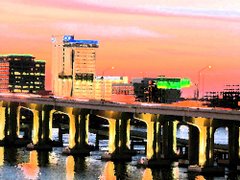
Jeff Bezos, the founder of Amazon is throwing his hat into the civilian space program. He has taken his first step with the November launch of Goddard. A vertical take-off and landing vehicle.
Blue Origin revealed
by Alan Boyle
After years of working behind closed doors and locked gates, Amazon.com founder Jeff Bezos has finally lifted the curtain that shrouded Blue Origin, his space tourism venture.
Among the goodies now displayed on Blue Origin's Web site are photos and videos from the venture's maiden test flight in November, as seen from the ground as well as a rocket-cam ... pictures from the West Texas launch range and Blue Origin's production facility in a Seattle suburb ... and even the Blue Origin coat of arms, emblazoned with the motto "Gradatim Ferociter" (Step by Step, Courageously).
Bezos founded Blue Origin in 2000, with the aim of developing a new type of vertical-takeoff, vertical-landing rocket ship capable of taking passengers to the edge of space. At altitudes in excess of 62 miles (100 kilometers), customers should be able to scan Earth's curving expanse beneath a black sky, experience a few minutes of weightlessness and justifiably brag afterward that they've been to outer space. Blue Origin's current development schedule calls for commercial trips to start in 2010.
Details about the operation have been hard to come by. That bit about 2010, for example, comes from the environmental assessment that was required in order for the Federal Aviation Administration to approve test flights at the Blue Origin launch facility, built on Bezos' sprawling ranch near Van Horn, Texas. Even the illustration on the cover of the draft report was adapted from the design for the Delta Clipper, an earlier-generation rocket ship.
Blue Origin's freshly updated Web site gives the public its first look at Goddard, the rocket prototype that's being used for the initial round of test flights. The cute, conical craft - named after rocket pioneer Robert Goddard - can be seen rising from a circular pad of concrete to a height of about 285 feet (87 meters), then coming back down to a soft landing.
Nine thrusters are on the craft's underbelly. In its literature, Blue Origin says it's developing a peroxide/kerosene propulsion system, so I have to assume that's what's being used here.
Accompanying all the snazzy graphics is a letter from Bezos himself, in which he explains Blue Origin's lofty goal:
"We’re working, patiently and step-by-step, to lower the cost of spaceflight so that many people can afford to go and so that we humans can better continue exploring the solar system. Accomplishing this mission will take a long time, and we’re working on it methodically. We believe in incremental improvement and in keeping investments at a pace that's sustainable. Slow and steady is the way to achieve results, and we do not kid ourselves into thinking this will get easier as we go along. Smaller, more frequent steps drive a faster rate of learning, help us maintain focus, and give each of us an opportunity to see our latest work fly sooner."
He also touts Amazon.com's S3 servers (which are housing the data on the Web site) as well as job opportunities at Blue Origin. The photos show the brand-spanking-new digs at Blue Origin's production facility in Kent, Wash. ... cheering employees at the maiden launch in Texas ... and even a grinning Bezos holding a broken champagne cork ("Fortunately, our other valve operations went more smoothly," he joked).
The employment angle appears to be the motivation behind the increased candor.
"As you noted, the new site does make more information available to potential applicants for positions at Blue Origin," Bruce Hicks, a Houston-based spokesman for the venture, told me in an e-mail.
The glasnost over Goddard still doesn't extend all the way, of course. For example, there's no mention of Blue Origin's second, less spectacular test run in December. In response to my inquiry about that, Hicks said, "I just want to remind you that we said previously we didn't plan to comment one way or another about tests, whether they are scheduled, were scheduled, happened, didn't happen, etc."
This means we'll just have to keep checking the FAA's notices to airmen for word of future tests.
Also, there's no reference to the potential price tag for the commercial flights to come. It may well be that Bezos hasn't yet set a price point (see "patiently and step-by-step," above).
For now, this week's revelations are enough: Based on the video of the first flight, it's clear that Blue Origin could give Armadillo Aerospace a serious run for NASA's money at the next Lunar Lander Challenge in New Mexico - just up the road a piece from Van Horn.





0 comments:
Post a Comment